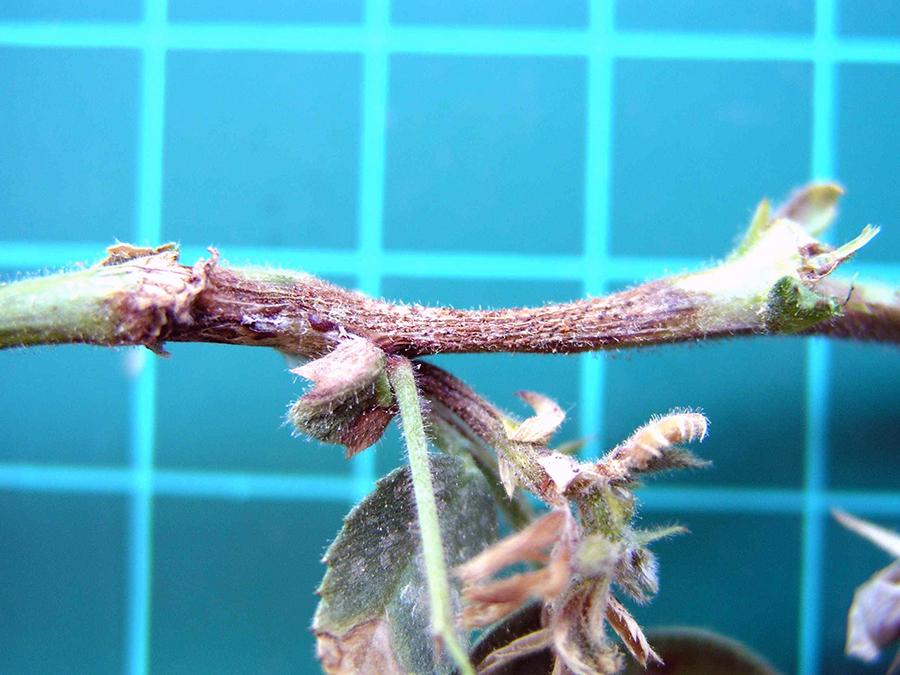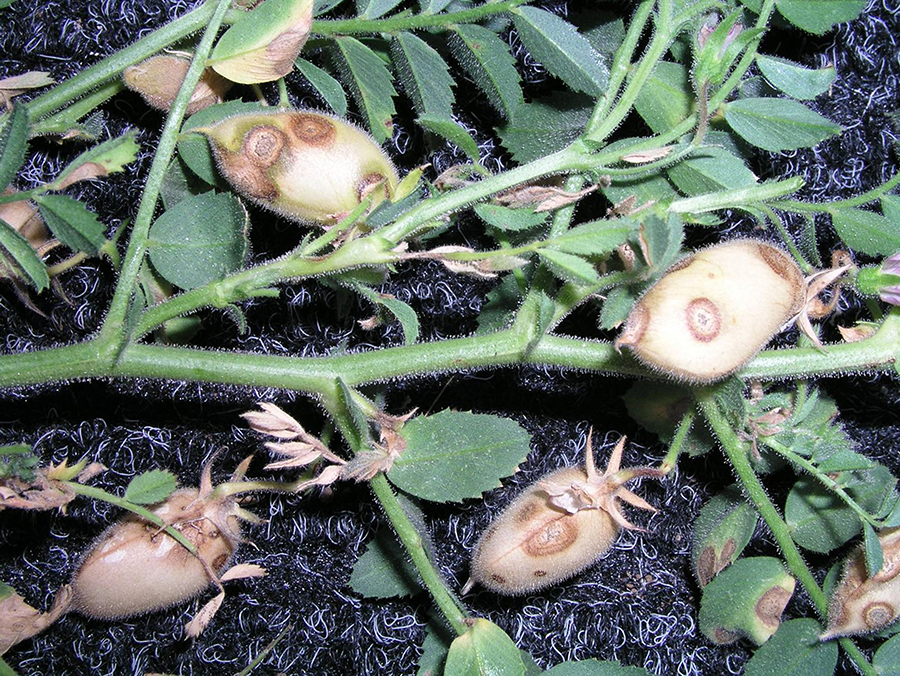Ascochyta blight found in some New South Wales crops in 2020 could still be in paddocks – warranting a pre-sowing disease check in 2021.
NSW Department of Primary Industries (DPI) plant pathologist Dr Kevin Moore says stubble infected with Ascochyta blight from previous seasons can still be present at seeding time the following year.
“If you can see intact chickpea stubble, assume that Ascochyta blight inoculum is viable in that paddock,” Dr Moore says.
“During 2020, there weren’t many crops in the Moree, NSW, area where I found Ascochyta blight, but there were several crops in the Macquarie, Lachlan and Castlereagh valleys where Ascochyta blight was found in September and October,” he says.
Fungus survival
Dr Moore says paddocks where Ascochyta blight was found during 2020 had a history of chickpeas and the fungus had survived on old chickpea residue during the drought years.

Ascochyta blight can develop quickly and kill large areas of crop. Photo: NSW Department of Primary Industries
“Those paddocks where Ascochyta blight was found during 2020 were managed successfully using the package we have developed through the Grains Agronomy and Pathology Partnership (GAPP) between NSW DPI and GRDC,” he says.
“But remember that the Ascochyta blight inoculum will still be on residue in those paddocks. It is also likely chickpea residue from those infected crops that exited from the rear of harvesters will have blown on to paddocks planted to wheat or barley in 2020.”
Dr Moore says 2021 chickpeas planted into 2020 wheat or barley stubbles that have been inoculated with Ascochyta blight-infected chickpea residue will be exposed to that inoculum.
“Those paddocks are high-risk for Ascochyta blight in 2021,” he says. “We recommend those paddocks are given a preventive fungicide spray before the first post-emergent rainfall event.”
Before sowing
Before chickpeas are planted, Dr Moore recommends selecting paddocks carefully by:
- avoiding planting chickpeas in the same paddock for at least three years;
- avoiding planting chickpeas immediately next to the paddock that was planted to last year’s chickpea crop;
- ensuring volunteer or ‘weed’ chickpea plants are controlled; and
- knowing your paddock’s risk rating.
A high-risk paddock is:
- any paddock where viable inoculum is known to be present; and
- where chickpeas have been grown in the past four years – 2020, 2019, 2018 or 2017.
High-risk seed is:
- seed of unknown pathogen status; and
- seed not properly treated with a registered fungicide.

Ensure seed fungicide is applied effectively. Effective application of P-Pickel T® (left) compared with poor application (right). Photo: NSW Department of Primary Industries
Dr Moore says the four steps to manage Ascochyta blight in high-risk paddocks with high-risk seed are:
- growing a variety with the highest level of Ascochyta blight resistance suitable for your area;
- treating all planting seed with a registered fungicide, applied properly;
- applying an Ascochyta blight fungicide before the first post-emergent rain event; and
- monitoring the crop 10 to 14 days after rain.
Pod infection
He says pod infection was evident in the Lachlan Valley region and near Trangie, Nevertire and Coonamble during October 2020.
“The seed from those pods could be internally infected with Ascochyta blight, but there’s another way seed transmission can pose a risk,” he says.
“If the crop has any Ascochyta blight, but it is not on the pods, when clean seed passes through the harvester it can be inoculated externally with infected chickpea residue.” If that harvester then moves into neighbouring chickpea crops that have never had Ascochyta blight, he says, clean seed can become inoculated with the fungus.

A chickpea stem infected with Ascochyta blight. Photo: NSW Department of Primary Industries
He says growers are often surprised to learn they have Ascochyta blight in their chickpeas when they have never previously grown chickpeas. But chickpea residue inoculated with the fungus can blow downwind and infect paddocks up to 20 to 30 kilometres away.
Fortunately, he says, if seed treatment is applied properly it provides 100 per cent control of seed-borne Ascochyta blight, whether it is internal and was acquired as a result of pod infection or whether it is external and was acquired through contamination.
Treat planting seed
Dr Moore says all planting seed should be treated with a registered fungicide, irrespective of seed age and origin. Even if seed has tested negative for Ascochyta blight, fungicide still should be applied, he says. This is because pathology tests are only done on a small percentage of seed.
“Effective application of fungicide should control seed-borne Ascochyta blight that is internal and external, seed-borne Botrytis seedling disease and protect seedlings from soil organisms that can reduce establishment and early vigour under less-favourable conditions such as cold or wet soils and deep planting,” he says.
“Research has shown that P-Pickel T®, which consists of thiram plus thiabendazole, and products containing thiram only, such as Thiram® 600, are equally effective against Ascochyta blight. Follow label directions, use the recommended rate and ensure effective coverage of the seed is achieved.”
Pod susceptibility
Dr Moore says the susceptibility of chickpea pods to Ascochyta blight is important to know because if pods become infected early in their development, they will abort and reduce grain yields.
“If they’re fully developed, but the stalk that holds the pod to the plant is infected, they will also abort,” he says.
“Pods with developing seeds will either abort or the seed becomes infected and the seed is killed or becomes infected and remains viable. This then becomes a potential source of inoculum to initiate an epidemic in the subsequent crop.”
He says a free seed-testing service is available to ensure seed is free from Ascochyta blight. Growers can send samples to Dr Kevin J Moore, Tamworth Agricultural Institute, 4 Marsden Park Road, Calala, NSW, 2340.
The varietal resistance of pods to Ascochyta blight infection is similar to that of the vegetative tissue of chickpeas. For example, he says the pods of a very susceptible variety such as Kyabra are more susceptible to Ascochyta blight than the stems and leaves of Kyabra.

Chickpea pods from different varieties differ in how susceptible they are to Ascochyta blight infection. Jimbour and Kyabra are the most-susceptible varieties. Photo: NSW Department of Primary Industries
Likewise, he says, the pods of PBA Seamer are more susceptible to Ascochyta blight than the stems and leaves of PBA Seamer.
“However, PBA Seamer pods are less susceptible to Ascochyta blight than Kyabra pods,” he says. “This is because PBA Seamer has improved resistance to Ascochyta blight during the vegetative stage and that is reflected during the reproductive stage when compared with Kyabra.”
During 2014, Dr Moore says a field experiment looked at pod infection for 10 varieties. “We found the varieties differed in the number of Ascochyta blight-infected pods and the severity of Ascochyta blight-infected pods.
“The most-susceptible varieties were Jimbour and Kyabra, followed by PBA Boundary, PBA HatTrick, Genesis Kalkee and PBA Monarch. The varieties with the least number of infected pods and the least severely infected pods were PBA Seamer and Genesis 0425.
More information: Kevin Moore, 0488 251 866, kevin.moore@dpi.nsw.gov.au

























































